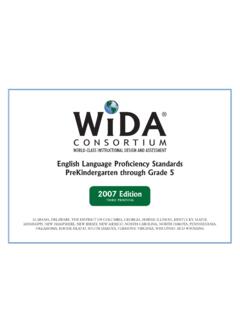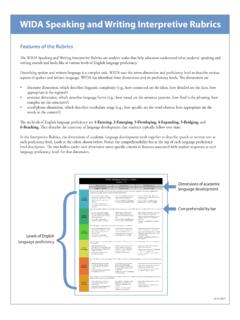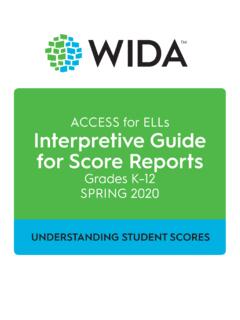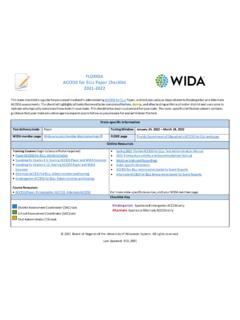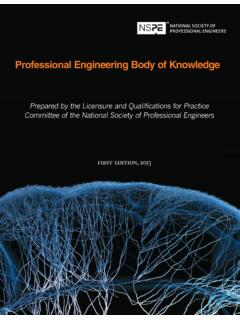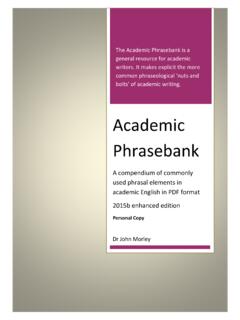Transcription of Can Do Descriptors - WIDA
1 Can Do Descriptors KEY USES EDITIONG rades 9-12 The WIDA Can Do Descriptors , Key Uses edition , Grades K 12 The WIDA Can Do Descriptors provide examples of what language learners can do at various stages of English language development in listening, speaking, reading and writing. The WIDA Can Do Descriptors , Key Uses edition is one component of the WIDA Standards Framework (shown at right). The framework, as a whole, supports the implementation of the WIDA English Language Development Standards in the instruction and assessment of language learners. We encourage educators to use the WIDA Can Do Descriptors , Key Uses edition in conjunction with the other components of the framework, along with the previous edition of the Can Do Descriptors . For more information on the WIDA Standards Framework, visit The WIDA Can Do Descriptors , Key Uses edition provides examples of academic language use for four specific communicative purposes.
2 These purposes, referred to as Key Uses, were identified based on reviews of literature and a language analysis of college and career readiness standards: Recount: To display knowledge or narrate experiences or events. Example tasks for the Key Use of Recount include telling or summarizing stories, producing information reports, and sharing past experiences. Explain: To clarify the why or the how of ideas, actions, or phenomena. Example tasks for the Key Use of Explain include describing life cycles, sharing why or how things work, stating causes and effects, and sharing results of : To persuade by making claims supported by evidence. Example tasks for the Key Use of Argue include stating preferences or opinions and constructing arguments with : To interact with others to build meaning and share knowledge.
3 Example tasks for the Key Use of Discuss include participating in small or large group activities and WIDA Can Do Descriptors , Key Uses edition and the example Descriptors are not exhaustive but are meant to help guide the planning and conversation around meaningful participation of language learners in stardards-based contest curriculum, instruction, and assessment. 2 Exemplifying the WIDA Can Do PhilosophyPerformanceDe nitionsStandards & their MatricesGuiding Principles of Language DevelopmentDevelopmentally-Appropriate Academic Languagein Sociocultural ContextsWIDA Standards FrameworkOrganization of the WIDA Can Do Descriptors , Key Uses edition , Grades K 12 The WIDA Can Do Descriptors , Key Uses edition is organized by grade-level bands (K, 1, 2 3, 4 5, 6 8, and 9 12) that correspond to those in ACCESS for ELLs Within each grade-level band, the Descriptors are organized by Key Use (Recount, Explain, Argue and Discuss) and within each Key Use, there are example Descriptors for WIDA s six levels of language proficiency (ELP Levels 1 6).
4 The Descriptors in Level 6 represent the language performance of students who have met all the criteria for Level 5. Unlike the Descriptors at Levels 1 5 that provide examples of performance at the end of the level, the Descriptors at Level 6 are examples of performance within Level 6. For three of the Key Uses (Recount, Explain, and Argue) you ll see Descriptors for the four language domains (Listening, Reading, Speaking, and Writing). The Descriptors for the Key Use Discuss are only shown for oral language. The Key Use Discuss highlights the importance of oral language development for meaningful participation of all language learners, regardless of their level of language proficiency. Potential Uses for the WIDA Can Do Descriptors , Key Uses edition AudiencesThe WIDA Can Do Descriptors , Key Uses edition can who work with language learners, including coaches, teachers ( , general education, gifted and talented, special education, Title I), language specialists, and support staff.
5 Differentiate curriculum, instruction, and assessments designed in English based on language learners levels of English language proficiency Collaborate and engage in instructional conversations about the academic success of language learners in English environments Advocate for equitable access to content for language learners based on their level of language proficiencyAdministrators and school leaders Communicate with other educators about students English language development Support the WIDA Can Do Philosophy throughout schools and districts Advocate for equitable access to content for language learners based on their level of language proficiencyStakeholders are encouraged to use the Can Do Descriptors beyond the audiences and purposes identified above to advocate on behalf of
6 Language Level 1 EnteringELP Level 2 EmergingELP Level 3 DevelopingELP Level 4 ExpandingELP Level 5 BridgingELP Level 6 ReachingLISTENINGP rocess recounts by Matching everyday oral content-related words and phrases to pictures, diagrams, or photographs Selecting resources, places, products, or figures from oral statements and visual supports Process recounts by Matching oral descriptions of characters or main events in content-related topics Following modeled oral commands Process recounts by Identifying main ideas from short content-related oral presentations Classifying examples of genres read aloud ( , types of narration)Process recounts by Following the steps of content-related tasks or assignments given orally Identifying details from oral discussions ( , when, who, where, what, and why)Process recounts by Reconstructing past experiences or series of events based on oral discourse Recognizing nuanced meanings of words and phrases in extended oral discourse Process recounts by Categorizing perspectives of multiple speakers Identifying important information on specific events and concepts from lectures and presentations SPEAKINGR ecount by Naming and briefly describing content topics using visual support ( , posters, diagrams, pictures)
7 Answering select yes/no or Wh-questions Recount by Restating information using content-specific terms Providing examples of content-related information previously studiedRecount by Posing and responding to questions in small group discussions Describing the sequence of processes, cycles, procedures, or events with detailsRecount by Presenting factual information on content-related topics to the class Paraphrasing and summarizing content-related ideas in large and small groupsRecount by Engaging in extended discussion of effects, impacts, or events related to content topics Giving multimedia oral presentations on content-related material learned from various sourcesRecount by Adjusting presentation style, degree of formality, word choice, tone, and information to the context and audience Presenting information that follows discipline-specific organization ( , orientation to topic, sequence of events, conclusion)
8 KEY USE OF RECOUNTBy the end of each of the given levels of English language proficiency* English language learners *Except for Level 6, for which there is no Level 1 EnteringELP Level 2 EmergingELP Level 3 DevelopingELP Level 4 ExpandingELP Level 5 BridgingELP Level 6 ReachingREADINGP rocess recounts by Matching key content-related terms and ideas to images, graphs, icons, or diagrams Sequencing illustrated text of narrative or informational eventsProcess recounts by Identifying patterns specific to narrative or informational text ( , orientation, presentation of events, conclusion) Locating main ideas in a series of related sentencesProcess recounts by Recognizing lexical chains that show how characters and ideas are labeled across the text Identifying detailed descriptions, procedures, and information in paragraphsProcess recounts by Identifying how the authors make language choices and adjusts for audience and purpose Reflecting on various accounts of a subject told in different media ( , print and multimedia)
9 Process recounts by Identifying how text structure supports comprehension and retrieval of information and details Identifying the central idea or theme and how it is supported by clear descriptions and extended detailsProcess recounts by Analyzing and comparing how authors use language for specific purposes and audiences Identifying how authors develop and maintain cohesion by connecting ideas or events in extended textsWRITINGR ecount by Listing content words or phrases that relate to the topic Including images, diagrams, and charts to add details to the topic Recount by Following patterns specific to narrative or informational text ( , orientation, presentation of events, conclusion) Sequencing narratives or informational text using linking words and phrasesRecount by Summarizing content-related material Including important information and related details Recount by Creating narrative or informational extended text of past events or experiences ( , lab reports, current events)
10 Connecting main points, events, and central ideas to conclusionsRecount by Sequencing using language that creates coherence Organizing information according to content-specific expectations Recount by Summarizing content-related notes from lectures or readings Producing research reports using multiple sources of information KEY USE OF RECOUNTBy the end of each of the given levels of English language proficiency* English language learners *Except for Level 6, for which there is no Level 1 EnteringELP Level 2 EmergingELP Level 3 DevelopingELP Level 4 ExpandingELP Level 5 BridgingELP Level 6 ReachingLISTENINGP rocess explanations by Ordering events or stages of phenomena from oral statements Identifying words and phrases related to sequence Process explanations by Sequencing steps in processes or procedures described orally Comparing information, symbols.



